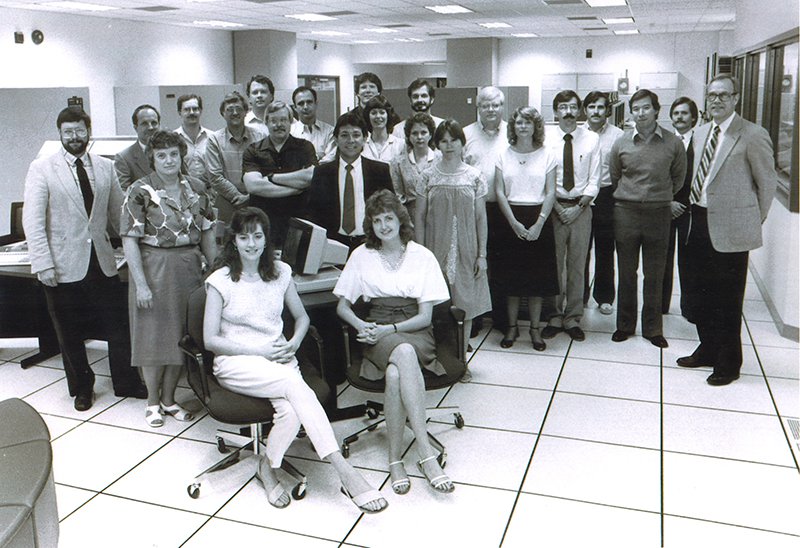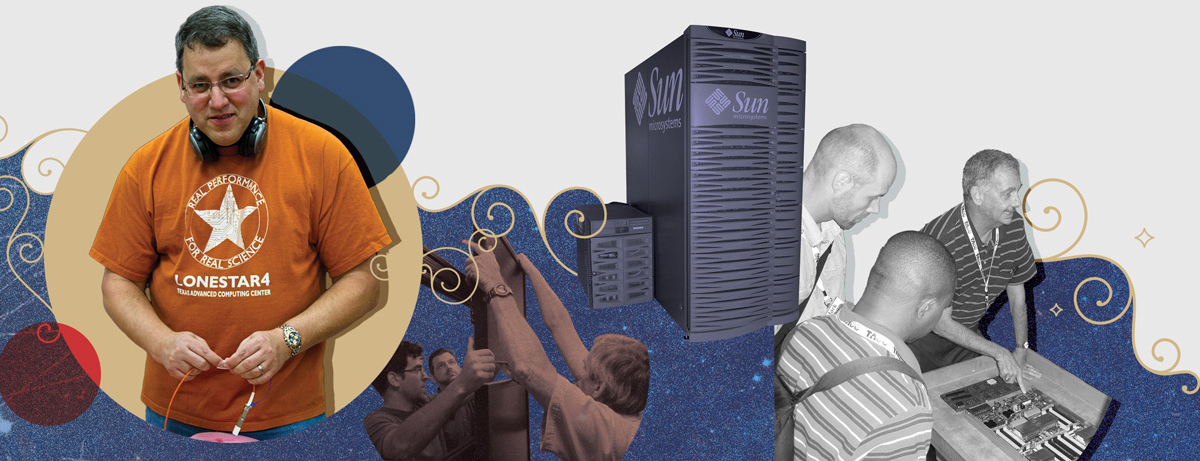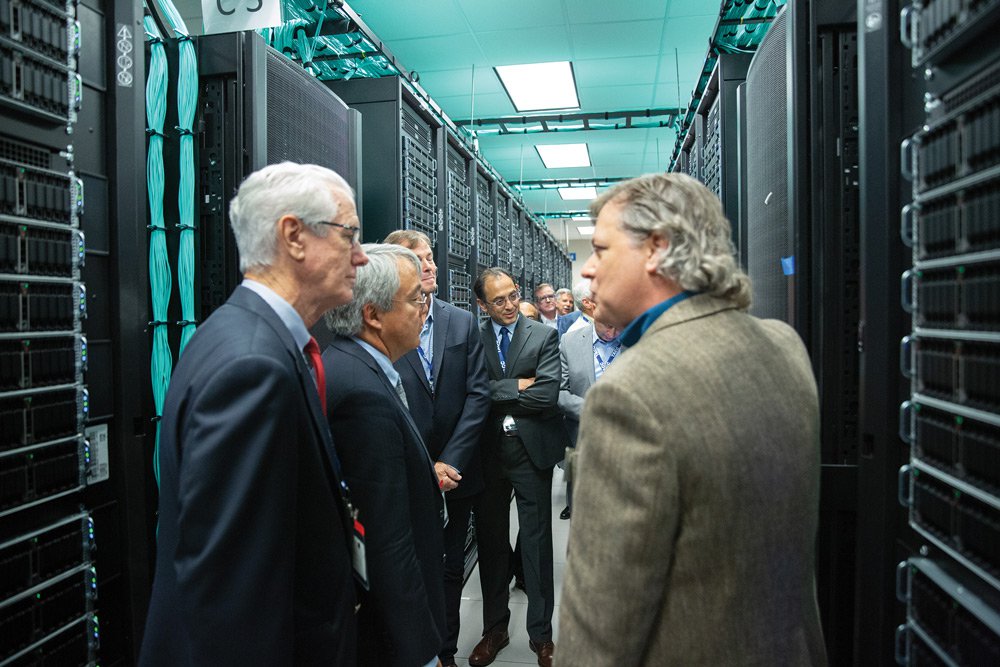Calls from HPC advocates like Oden and many others had grown so loud throughout the 1980s and 1990s, university leadership couldn’t ignore them any longer.
“When I became president of UT in 1998, there was already a lot of discussion around the need to prioritize advanced computing — or ‘big iron’ as we called it back then — at the university,” said former UT President Larry Faulkner.
In 1999, Faulkner named Juan M. Sanchez as Vice President for Research (VPR), an appointment that proved central to the TACC story. Instrumental in a variety of university initiatives, Sanchez echoed the calls from HPC advocates to build a home for advanced computing at UT.
Lonestar3 supercomputer, with TACC Senior Systems Administrator Laura Timm Branch. Credit: TACC.
Two years later those calls were answered. In 2001, a dedicated facility was established at UT’s J.J. Pickle Research Campus in north Austin with a small staff led by Jay Boisseau, who influenced the future direction of TACC and the wider HPC community.
TACC grew rapidly in part due to Boisseau’s acceptance of hand-me-down hardware, an aggressive pursuit of external funding, and success forging strong collaborations with technology partners, notably hometown success story, Dell Technologies.
The center also enjoyed access to a rich pipeline of scientific and engineering expertise at UT.
One entity in particular became a key partner — the Institute for Computational Engineering and Sciences (ICES). Established in 2003, ICES also enjoyed the support of then VPR Sanchez, another calculated risk that proved successful. Renamed as the Oden Institute for Computational Engineering and Sciences, in recognition of its founder J. Tinsley Oden, the institute quickly became regarded as one of the leading computational science and engineering (CSE) institutes in the world.
Thanks to the unwavering support of Texan educational philanthropists Peter and Edith O’Donnell, Oden was able to recruit the most talented computational scientists in the field and build a team that could not only expand the mathematical agility of CSE as a discipline, but also grow the number of potential real-world applications.
“ICES was such a successful enterprise, it produced great global credibility for Texas as a new center for HPC,” Faulkner said.
Computational science and advanced computing tend to move forward symbiotically, which is why Oden Institute faculty have been instrumental in planning TACC’s largest supercomputers, providing insights into the types of computing environment that researchers require to deliver impactful research outcomes.
“Computational science and engineering today is foundational to scientific and technological progress — and HPC is in turn a critical enabler for modern CSE,” said Omar Ghattas, who holds the John A. and Katherine G. Jackson Chair in Computational Geosciences with additional appointments in the Jackson School of Geosciences and Mechanical Engineering.
Ghattas has served as co-principal investigator on the Ranger (2008) and Frontera (2018) supercomputers and is a member of the team planning the next-generation system at TACC.
“Every field of science and engineering, and increasingly medicine and the social sciences, relies on advanced computing for modeling, simulation, prediction, inference, design, and control,” he said. “The partnership between the Oden Institute and TACC has made it possible to anticipate future directions in CSE. Having that head start has allowed us to deploy systems and services that empower researchers to define that future.”
No(de) Time for Complacency
Over its first 10 years, TACC deployed several new supercomputers, each larger than the last, and gave each a moniker appropriate to the confident assertion that everything is bigger and better in Texas — Lonestar, Ranger, Stampede, Frontera.
While every system was and still is treated like a cherished member of TACC’s family, current Executive Director Dan Stanzione doesn’t flinch when asked to pick a favorite child. “We really got on the map with Ranger,” said Stanzione, who was a co-principal investigator on the Ranger project.
The successful acquisition of the Ranger supercomputer in 2007, the first “path to petascale” system deployed in the U.S., catapulted TACC to a national level of supercomputing stardom. At this point, Stanzione was the Director of High Performance Computing at Arizona State University but was playing an increasingly important role in TACC operations.
Ranger was slated to be the largest open science system in the world at that time, and TACC was still a relatively small center compared to other institutions bidding for the same $59 million NSF grant. TACC’s chances of successfully winning the award had its fair share of skeptics.
However, Stanzione (who officially joined TACC as deputy director soon after the successful Ranger bid) and Boisseau were a formidable pair.
“TACC has a reputation for punching above its weight,” Oden said. “Jay and Dan just knew how to write a proposal that you simply could not deny.”
Stanzione continued the winning approach when he took over as executive director in 2014. In addition, he has held the title of associate vice president for research at UT since 2018.
“Juan Sanchez also made the decision to appoint Stanzione as Jay Boisseau’s successor,” Faulkner noted. “And while the success of TACC has, of course, come from those actually working in the field, Sanchez deserves great credit for establishing an environment where that success could thrive.”
The environment at TACC is certainly unique in academia, rarely known for producing agile organizations. In particular, the center stands out for the entrepreneurial culture it has cultivated over the years.
Stanzione describes the approach as being akin to a startup. “We were hungry to win the Ranger contract and, against the odds, it paid off.”
The Formula for Success
TACC has kept its edge for 20 years by prioritizing the needs of researchers and maintaining strong partnerships.
“TACC has repeatedly demonstrated integrity and commitment to the relationships it has with academics, industry, and government,” said Irene Qualters, associate laboratory director for Simulation and Computation at Los Alamos National Laboratory and former head of advanced computing at NSF, speaking in a personal capacity.
“The work that has been done with Dell Technologies, for example, that was only just emerging as a player in the HPC space when the connection was originally made, has really endured. I think there’s something uniquely Texan to TACC’s success. TACC has always done things their own way and, in doing so, they’ve become a national exemplar.”



